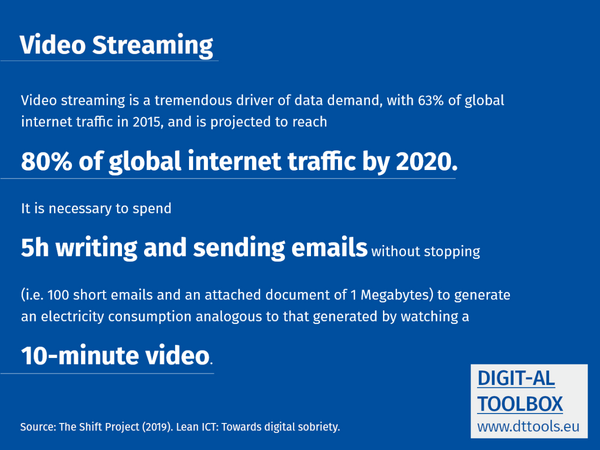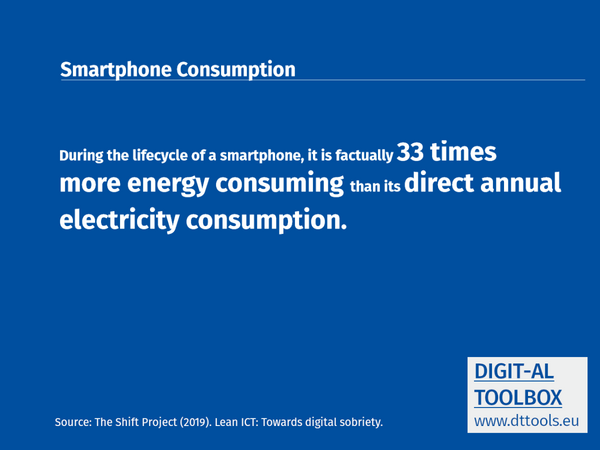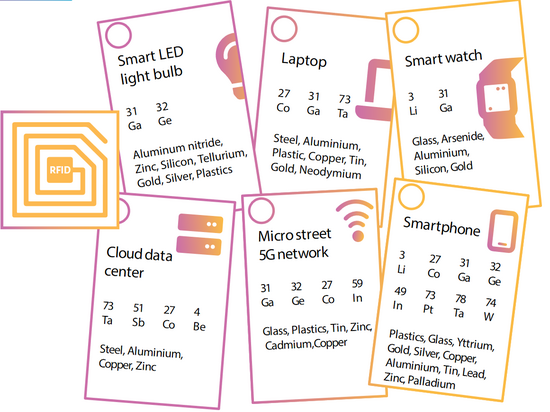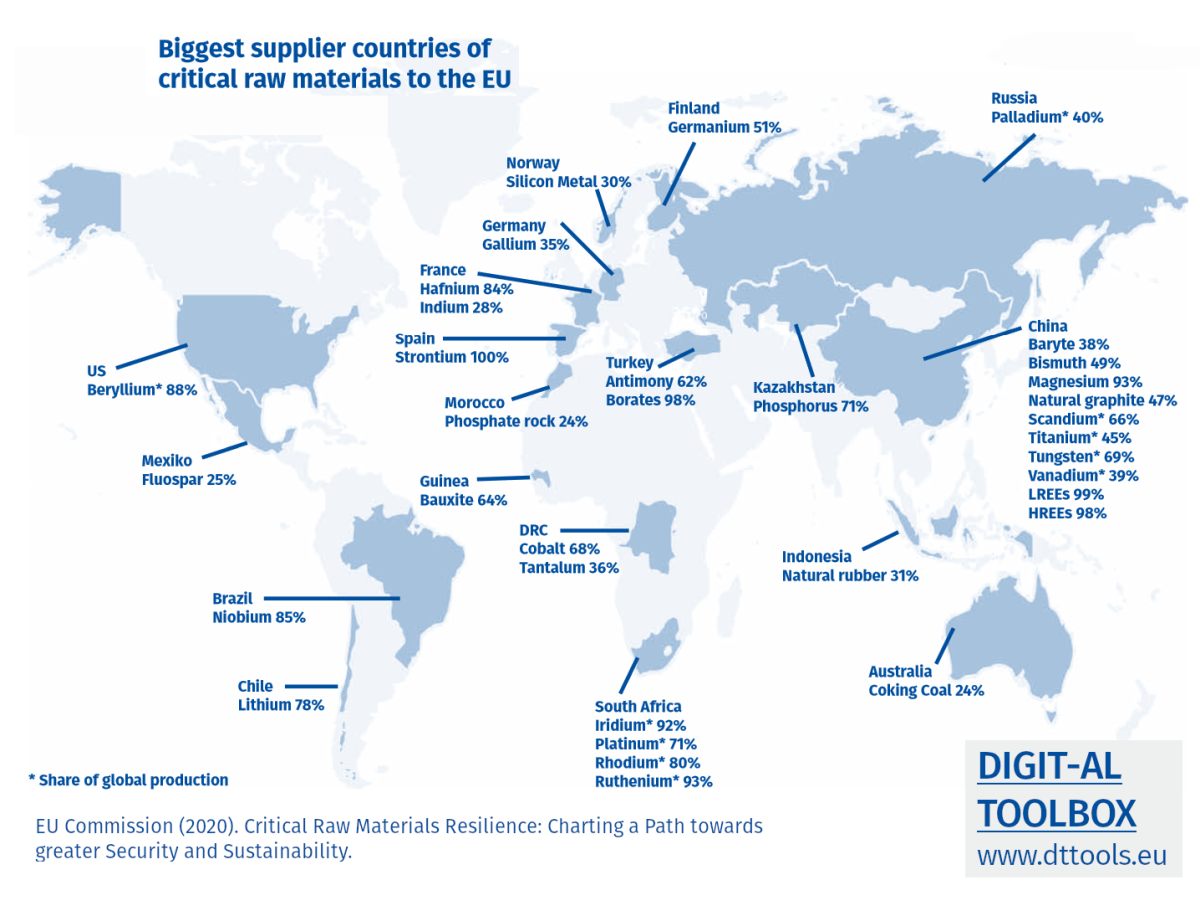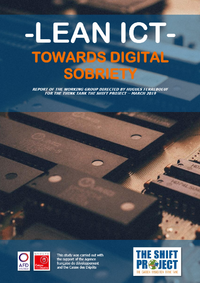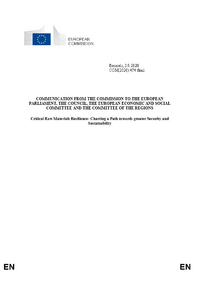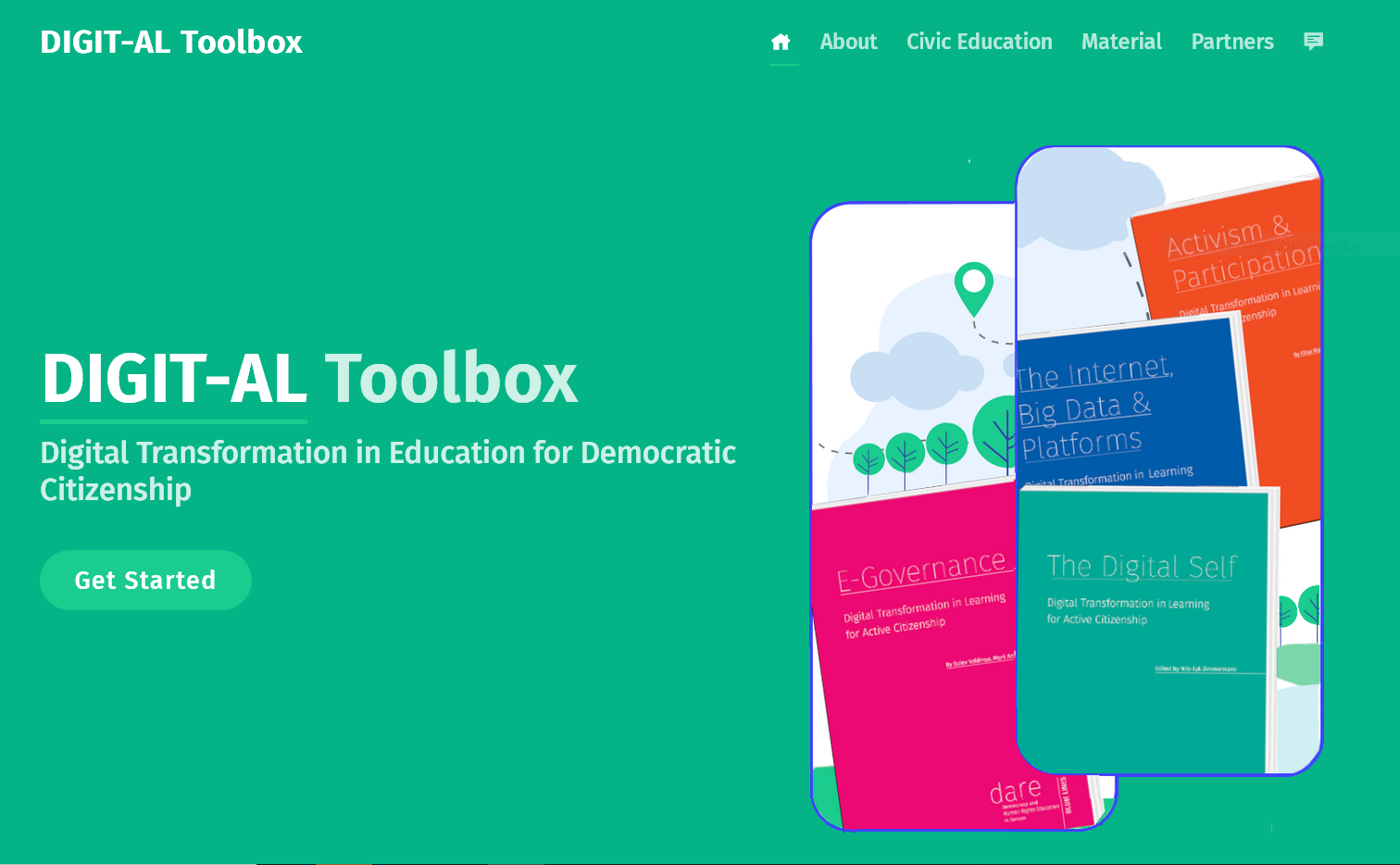Contents
- 1 Energy
- 2 Size matters
- 3 Production and Consumption
- 4 Procurement Criteria
- 5 Longer Usage
- 6 Circular Economy & E-Waste
- 7 Raw Materials and Globalisation
- 8 Digital Sustainability
- 9 Aspects of Digitalisation in Education for Sustainable Development, more Sustainability into Learning about Digitalisation
- 10 References
- 11 Further Reading/Material for Education
Energy
In times of climate change, maybe energy hunger is the most obvious aspect which comes into mind when thinking about the relation between the environment and digitalisation. The efficiency gains by technological advancement are insufficient in compensating the growing need for electricity. Although the global platforms are moving toward renewable energy, the rebound effect lets us consider, where to twiddle the necessary knobs (Greenpeace, 2017). According to Greenpeace, by 2030, 13% of the global electricity will go to data centres.

Energy demand of servers and data centres in Germany; Source: Hintemann 2020
In line with efforts to create a carbon free energy future, digital practices might also be better reflected. For instance, video streaming is clearly identified as an activity with a huge potential for reduction. Will we experience again a way back to “old fashioned” downloads, and will there be incentives to reduce consumptive internet traffic? The current developments show us moving in the opposite direction, rather mainstreaming the model of streaming digital entertainment by investing in the necessary server power.
Current developments show the opposite tendency, as the streaming model is spreading rather than being reduced by investments in the necessary server power. Clouds are replacing more and more local servers. The example also shows that environmental education about the energy consumption of end consumers must also take into account more resource-saving practices of digital business models.
Also AI models have a huge energy demand and carbon footprint. More than 35.000 kg are required in order to train a large foundation AI system (Hao 2019). The carbon footprint of three Germans in 2021.
Check your internet’s ecological footprint
The Danish movement Ecotree has developed a CO2 calculator which takes into account internet usage in private households. This may give an idea of what individuals can optimize, although the carbon footprint of the Internet is different in European countries (due to their specific energy mix) and does not include indirect CO2 caused by internet infrastructure.
Video: Frankenstream
Learn about the environmental impact of streaming. 4 parts, ARTE/ALLSO, 2022. Director: Pierre-Philippe Berson, Adrien Pavillard.
- At ARTE: Frankenstream the devouring monster.
Resource: Low Tech Magazine: Technology scepticism for technological innovation
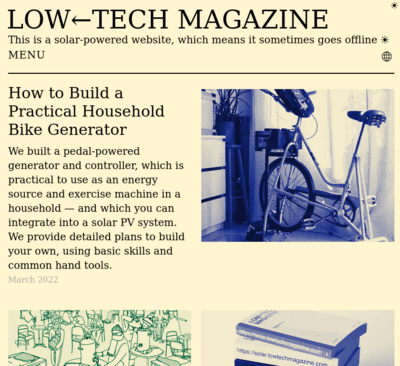
The considerations above express scepticism that an environmentally neutral or even a positive contribution of digitalisation is possible. More electric infrastructure can be accompanied by more energy-efficiency or it can lead simply to more consumption. Are new technologies really more energy efficient? It is also questionable whether green energy can replace energy production from fossil fuels. A critical and curious look into alternatives might provide helpful hints.
Low Tech Magazine talks about the potential of past and often forgotten knowledge and technologies. Interesting possibilities arise when you combine old technology with new knowledge and new materials, or when you apply old concepts and traditional knowledge to modern technology. The editor of lowtechmagazine Kris De Dekker, was also involved in various arts-based projects igniting thought for an alternative vision for using technology, such as the Human Power Plant, generating energy for a local event by pedal power.
Size matters
In 2016, Ronan Cremin found out that the average webpage then required users to download about 2.3MB worth of data, approximately the same amount of data required by the first installation of the 3D game Doom (Finley, 2016). While publishing on the Internet has become much easier through blogs, content management systems and coding through new platforms, we might also reflect on this critically. More pictures, responsive design, and animations have served as new user experience milestones, but some point in another direction. Flat-File CMS offer a lighter weight as a feature. Also, text processing and emailing have a huge potential for downsizing: images might be down-calculated, emails and documents might be sent in small sizes. Mediafiles might be downloaded one time instead of being streamed continuously.
But why would we need to take care of size when the Internet’s infrastructure and accessibility in Europe does not require it? Efficiency by itself helps to optimize content and comprehensibility. Another aspect is accessibility, which might be more relevant from a global perspective. In many societies, citizens have limited access to the Internet. They experience lacking net neutrality or suffer from high costs for free internet and adequate hardware. Those accessing the Internet through privacy tools like the TOR network or a VPN connection enjoy more streamlined emails or websites.
Production and Consumption
Also the method of producing devices (including ever cheaper smartphones, tablets, TVs or digital notebooks) is leading to reduced life cycles and less willingness to repair or reuse devices. Prices which do not factor in the social and ecological costs of increasing ICT consumption, obsolescence by design, complicated repairability or lacking software support are pushing consumers to buy new products more often.
Decreasing Prices for Computers
1977 Apple II - $5,389 original price: $1,298
1985 Commodore Amiga 1000 - $3,028 original price $1,295
1999 Compaq ProSignia 330 - $4,076 original price: $2,699
2021 Lenovo Thinkpad T14 - $ 1.800
Source: USA Today (2018/06/22)
Miniaturisation is having also another consequence. Modular solutions, like old desktop computers which allowed owners to replace or renew parts, are extinct. The website Ifixit is empowering consumers to repair their devices with published guides and advocacy for a “right to repair”, according to the provocative question: “Would you buy a car if it was illegal to replace the tires?”
Beyond repair, refurbishing is also still a niche. Some resellers are offering checked and repaired hardware (often the longer lasting business hardware). However, there is a global demand for used and refurbished mobile phones of the top brands and models. Some producers like Apple are also starting offering used devices. However, Apple may be seen as an exemplary case - on the one hand they are trying to explore the field of used ICT and probably closing a niche, on the other hand the company is critically toward a right to repair and not very assistive to independent repair shops providing them original spare parts.
Procurement Criteria
Environmental labels and standards play a role primarily in public procurement and in companies. Despite the fact of already established seals for new hardware considering ecological and quality criteria, the broader public is not familiar with these. Cheap “consumer” devices are not listed in the database of the worldwide EPEAT seal. However, a buy of devices listed in the gold and silver categories might often pay off.
Longer Usage
According to a study by the United Nations, per capita worldwide 7.33 kg of e-waste was generated (Forti et al., 2020). A special characteristic of smartphones and tablets is that these devices are often are often rendered unusable by their manufacturers in an indirect manner by no longer offering security and software updates. Extending their useful life then enables rooting - bypassing the built-in security mechanisms, which in turn makes it possible to install free operating operating systems, which are supplied with security updates by a community beyond the manufacturer's support.The Free Software Foundation for instance is giving hints as to how to install a free Android operating system on smartphones and tablets (for instance LineageOS).
Owners of older Windows and Mac computers and laptops can often help themselves by installing another leightweight operating system, usually based on the free Linux. Thanks to dedicated programmers, there are slim operating system variants (so-called distributions) especially suited for older hardware.
Concrete Options...
- Used and refurbished devices, such as former business laptops or highend smartphones. Specific platforms focus on this kind of hardware and also some online sellers offer a "used" or "refurbished" section on their websites.
- Unlock your old Android Phone: Lineage OS
- More sustainable and energy-efficient hardware: EPEAT seal
- Printers with tanks instead cartridges
- slim operating system variants like Slim Linux on your old laptop or PC.
Circular Economy & E-Waste
The socio-political conception leading toward more sustainability and conscious use of resources is the circular economy. The EU is pushing it currently forward in the framework of its Green New Deal. In particular the EU Commission aims to come up with regulatory measures “for electronics and ICT including mobile phones, tablets and laptops under the Ecodesign Directive so that devices are designed for energy efficiency and durability, repairability, upgradability, maintenance, reuse and recycling.” It proposes also “to work toward establishing a new ‘right to repair’” and a Circular Electronics Initiative (EUC COM(2020) 98 final).
Raw Materials in the Internet of Things
Resource: The Global E-waste Monitor 2020
Quantities, flows and the circular economy potential (2020). United Nations University, International Telecommunication Union
The most comprehensive overview of the global e-waste challenge, explains how it fits into international efforts to reach the Sustainable Development Goals, and discusses how to create a sustainable society and circular economy. The report provides a national and regional analysis and makes predictions until 2030. It also encourages decision-makers to increase activities to measure and monitor e-waste using an internationally recognised methodological framework. https://www.itu.int/en/ITU-D/Environment/Pages/Spotlight/Global-Ewaste-Monitor-2020.aspx
Circular Economy Action Plan: Actions and Ambitions of EU
- Make sustainable products the norm in the EU;
- Empower consumers and public buyers;
- Focus on the sectors that use most resources and where the potential for circularity is high such as: electronics and ICT; batteries and vehicles; packaging; plastics; textiles; construction and buildings; food; water and nutrients;
- Waste reduction;
- Implement circularity as a key principle;
- Lead global efforts on circular economy.
Source: Circular Economy Action Plan
Quick Key Facts on E-Waste
The environmental news platform EcoWatch has compiled some facts on the subject:
- E-waste is the fastest-growing waste stream in the world; between 50 and 60 million tons are produced every year. The e-waste discarded in 2021 alone weighs more than the Great Wall of China: the heaviest man-made structure in the world.
- 75-80% of e-waste is shipped to countries in Africa and Asia, where poor and marginalized communities suffer health and environmental consequences. Electronics contain hazardous materials like lead, mercury, and cadmium, which leach into the surrounding environment when placed in landfills, or when the products are burned by “backyard recyclers” in Global South trying to extract valuable materials like gold and copper
- Less than 20% of e-waste generated each year is properly recycled.
- E-waste contains valuable materials that can be extracted through proper recycling. It’s estimated that unrecycled e-waste contains $57 billion worth of recoverable precious metals.
Source: EcoWatch: E-Waste 101: Everything You Need to Know
Raw Materials and Globalisation
The lavish hardware consumption is also possible because most devices in 2020 are produced in China and Vietnam (Wired, 2019), countries with low wages, because the necessary raw materials (rare earth) often come from conflict regions, or because the social and environmental consequences of their extraction and the e-waste exported to poor countries (Parajuly et al., 2019) are not priced in. A circular economy approach softens the negative environmental and social effects of raw material exploitation.
The demand for raw materials is constantly increasing and globally they are unequally distributed. In their report, “Critical Raw Materials Resilience: Charting a Path towards greater Security and Sustainability”, the EU explores the European raw material dependence, with a view on global demand, concluding that “despite improvements in materials intensity and resource efficiency” still 110% more raw materials need to be exploited in 2060 compared to 2011 and by a total of 167 billion tons (EU-COM 2020/474 final, p. 5).
Today, initiatives for fair trade or conflict-free IT aiming to strengthen the position of workers involved in the manufacturing process and also the position of production societies in world trade have not yet made a significant impact, although some initiatives like the project, Make ICT Fair (engaging for more fair public procurement policies) or Fairphone or Shiftphone, are raising awareness about the production conditions of hardware. But in general, a fair European approach to “Critical Raw Materials Resilience” would need to prove that ethical words and fair global cooperation are a priority of European policies and economic practices.
Digital Sustainability
If Sustainable development is "development that meets the needs of the present without compromising the ability of future generations to meet their own needs" - what characterizes digital sustainability? The German association LuKi (Linux users in the field of churches) suggests in their Initiative on Digital Sustainability the characteristics from all fields of sustainability:
Digital Sustainability Characteristics
- Digital goods must be financially, technically and organisationally usable and changeable for all people.
- Passing on and preserving knowledge requires a design of digital goods that is open to the future and remains accessible.
- Open formats, open standards and free licences are necessary in order to pass on knowledge and preserve it for future generations.
- Accessibility to digital goods should be independent of financial wealth.
- Knowledge about digital goods must be distributed across many actors and not held by just one person or organisation.
- Knowledge about digital goods must be regenerable and reproducible.
- The transfer, reuse and modification of digital goods must be technically and legally possible and encouraged.
- Digital goods (especially software) must be designed in such a way that they do not create dependencies on their producers, as well as originate transparently (source code) and are trustworthy.
- A sensible structuring, modularisation, documentation, findability and the most precise possible filtering of digital goods must be guaranteed.
- It is necessary to create supportive individual and social framework conditions, as well as corresponding legal regulations, so that sustainable digital goods are promoted and preferred on a broad front.
After: LuKi
Aspects of Digitalisation in Education for Sustainable Development, more Sustainability into Learning about Digitalisation
The Internet and the digital transformation as a whole effect the whole world, but in different ways. Digital transformation can be explored as a phenomenon of globalisation, also included in global competence learning, for example in line with the global competence framework of OECD PISA:
Global Competence
“Global competence is the capacity to examine local, global and intercultural issues, to understand and appreciate the perspectives and world views of others, to engage in open, appropriate and effective interactions with people from different cultures, and to act for collective well-being and sustainable development” (OECD PISA, 2018).
Education for Sustainable Development (ESD) addresses corresponding aspects in its various ESD goals, takes up corresponding aspects (compare UNESCO 2017). Environmental education also includes topics such as energy consumption,circular economy, sustainable production, repairability or recycling and must be expanded to include the context of the digital be expanded.
Civic education can broaden the view beyond the end-user's practice end-user practice by also reflecting on the conditions for their networking and their conditions for their networking and functioning. Ultimately, it is not virtual platforms, but rather concrete power plants, factories, data centers and means of transport that make global digitization possible and in the process and leave behind a larger or smaller ecological footprint. These concrete enablers or barriers to sustainable sustainable digitization deserve more attention from political educational practice.
Global learning can contribute to understanding the impact of the digital transformation. The countries of Europe are an important and influential part of the global Internet. If Europe, as the European Commission has set itself the goal, a "European path" to digitalization, Europeans must also ask themselves Europeans must also ask themselves what global vision they share in terms of ecological vision they share in terms of ecological responsibility, and what global responsibility arises from this claim.
Europe-related education is also called upon to consider the question of the effects of the European path of digitalization with regard to environmental and environmental and social aspects within and outside Europe.
Nils-Eyk Zimmermann
Editor of Competendo. He writes and works on the topics: active citizenship, civil society, digital transformation, non-formal and lifelong learning, capacity building. Coordinator of European projects, in example DIGIT-AL Digital Transformation in Adult Learning for Active Citizenship, DARE network.
Blogs here: Blog: Civil Resilience.
Email: nils.zimmermann@dare-network.eu
References
European Commission (EU-COM 2020/474 final). Communication from the Commission to the European Parliament, the Council, the European Economic and Social Committee and the Committee of the Regions – Critical Raw Materials Resilience: Charting a Path towards greater Security and Sustainability.
European Commission (EU-COM (2020) 98 final). Circular Economy Action Plan; For a cleaner and more competitive Europe; Brussels, 11.3.2020.
Finley, K. (2016). The Average Webpage Is Now the Size of the Original Doom. Wired, 2016/04/23; https://www.wired.com/2016/04/average-webpage-now-size-original-doom/
Forti V., Baldé C.P., Kuehr R., Bel G. (2020). The Global E-waste Monitor 2020: Quantities, flows and the circular economy potential. United Nations University (UNU)/United Nations Institute for Training and Research (UNITAR) – co-hosted SCYCLE Programme, International Telecommunication Union (ITU) & International Solid Waste Association (ISWA), Bonn/Geneva/Rotterdam. ISBN Digital: 978-92-808-9114-0, ISBN Print: 978-92-808-9115-7. Access at 2021/08/01
Greenpeace (2017). Clicking Clean: Who is Winning the Race to Build a Green Internet? Cook, G. et al., Greenpeace Inc.: Washington.
Hao, Karen (2019/06/06). MIT Technology Review. Training a single AI model can emit as much carbon as five cars in their lifetimes. Deep learning has a terrible carbon footprint.
Hintemann, R. (2020). Rechenzentren 2020. Cloud Computing profitiert von der Krise. Energiebedarf der Rechenzentren steigt trotz Corona weiter an. Borderstep Institut, Berlin 2020.
OECD PISA (2018). Preparing our Youth for an Inclusive and Sustainable World. The OECD PISA global competence framework. Directorate for Education and Skills, Paris.
Parajuly, K.; Kuehr, R.; Awasthi, A. K.; Fitzpatrick, C.; Lepawsky, J.; Smith E.; Widmer, R.; Zeng, X. (2019). Future E-waste Scenarios. StEP (Bonn), UNU ViE-SCYCLE (Bonn) & UNEP IETC (Osaka). Access at 2021/08/01 1.8.21
The Shift Project (2019). Lean ICT: Towards digital sobriety. Report of the Working Group directed by Hugues Ferreboeuf for the Think Tank The Shift Project. March 2019.
UNESCO (2017). Education for Sustainable Development Goals: learning objectives. Paris.
USA Today (2018/10/03). Comen, E.: Check out how much a computer cost the year you were born.
Wired (2019/09/02). Chris Stokel-Walker: China's quickly losing its position as the world's smartphone factory
The Internet, Big Data & Platforms
This text was published in the frame of the project DIGIT-AL - Digital Transformation Adult Learning for Active Citizenship.
Zimmermann, N.: The Internet, Big Data & Platforms (2020). Part of the reader: Smart City, Smart Teaching: Understanding Digital Transformation in Teaching and Learning. With guest contributions of Viktor Mayer-Schönberger, Manuela Lenzen, Irights.Lab and José van Dijck and contributions of Elisa Rapetti and Marco Oberosler. DARE Blue Lines, Democracy and Human Rights Education in Europe, Brussels 2020.

Further Reading/Material for Education



